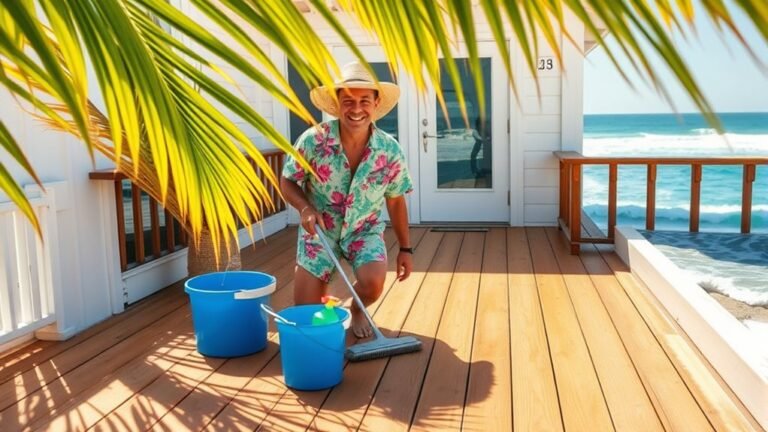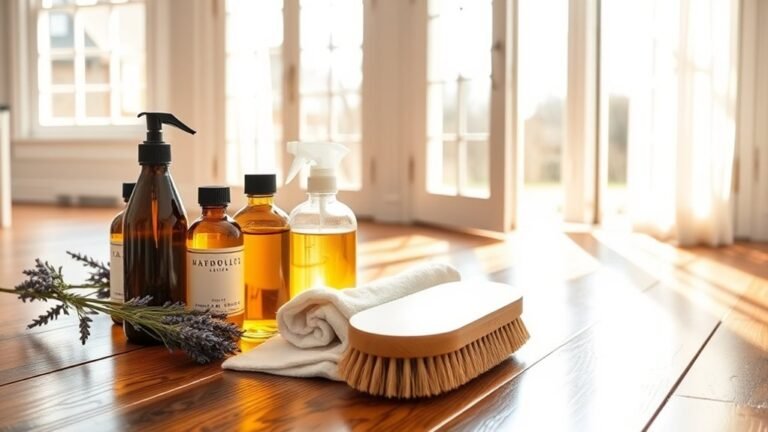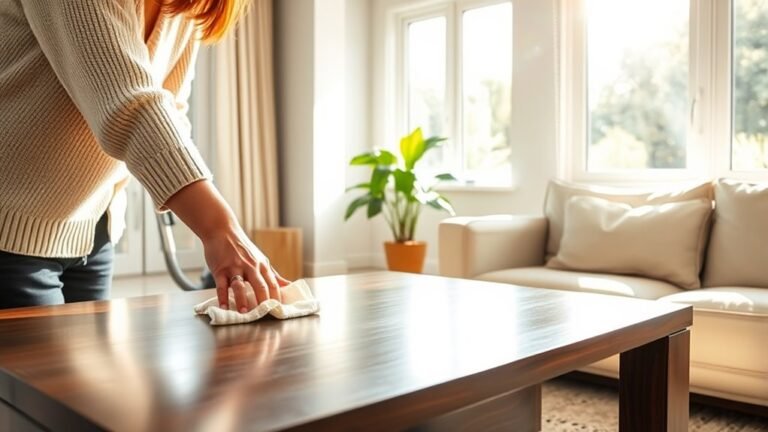How to Reduce Water Usage While Cleaning
To reduce water usage while cleaning, soak dishes before scrubbing, use a controlled stream to rinse, and air dry to save water. Run full laundry loads on cold cycles and choose eco-friendly detergents. For floors, use microfiber mops with minimal water and efficient cleaning patterns. In the bathroom, rinse with a bucket and wipe surfaces instead of rinsing under running water. Using natural cleaning products also helps reduce waste. Keep these smart habits in mind, and you’ll find even more ways to conserve water as you go.
Optimize Dishwashing Techniques

When you optimize your dishwashing techniques, you can greatly cut down on water use without sacrificing cleanliness. Instead of letting the water run, use the soak technique: fill your sink or a basin with soapy water and let your dishes sit for a few minutes to loosen grime. This way, you avoid wasting water while scrubbing. After soaking, wash your dishes efficiently and rinse them briefly with a controlled stream of water. Using a dish rack to air dry your dishes not only saves water but also gives you the freedom to focus on other tasks. By adopting these simple steps, you take control of your water usage, reduce waste, and maintain a clean kitchen without feeling tied down by inefficient habits.
Efficient Laundry Practices
You can save a lot of water by always running full laundry loads instead of smaller ones. Using cold water for your washes reduces water heating needs and helps conserve energy. Also, picking eco-friendly detergents can make your laundry routine gentler on the environment.
Load Full Machines
Although it might be tempting to run smaller loads to save time, loading your washing machine and dishwasher to full capacity is one of the simplest ways to cut down on water use. When you fill your machines properly, you maximize machine efficiency, meaning every drop of water is put to good use. Running half-empty loads wastes both water and energy, locking you into unnecessary consumption. By respecting your appliance’s load capacity, you free yourself from frequent cycles, saving time and resources. This small shift in habit lets you enjoy the freedom of doing fewer chores while protecting the planet. So, next time you’re ready to clean, wait until you have a full load — it’s a smart, freeing way to reduce water waste effortlessly.
Use Cold Water
Since heating water accounts for a large portion of your laundry’s energy use, opting for cold water cycles can greatly cut down both water heating costs and environmental impact. By choosing cold water, you tap into significant energy savings that not only lighten your utility bills but also reduce your carbon footprint. The cold water benefits extend beyond energy; it preserves your clothes’ colors and fabrics, meaning fewer replacements and less waste. You get to enjoy clean clothes without the guilt of excessive resource use. Embracing cold water washing gives you more control over your environmental impact, freeing you from unnecessary energy consumption. So next time you do laundry, don’t hesitate to switch to cold water—you’ll save money, protect your clothes, and help conserve our planet’s precious resources.
Choose Eco-friendly Detergents
Switching to cold water is a great start, but what you use to clean your clothes matters just as much. Choosing eco-friendly detergents with natural ingredients lets you protect the environment without sacrificing cleanliness. These biodegradable options break down quickly, reducing water pollution and helping preserve our planet’s freedom from harmful chemicals. When you pick detergents free from synthetic fragrances and harsh chemicals, you’re not only cutting water waste but also supporting a cleaner, healthier lifestyle. It’s about making smart choices that align with your values and give you control over your impact. So next time you shop, opt for detergents that respect nature, conserve water, and keep your laundry routine as green as your mindset. Your freedom to choose can make a difference.
Smart Floor Cleaning Methods
When it comes to floor cleaning, using efficient mopping techniques can help you cut down on water use without sacrificing cleanliness. You’ll also want to contemplate water-saving tools like microfiber mops or spray mops that use less water than traditional methods. These smart choices make your floors shine while conserving water.
Efficient Mopping Techniques
Using just the right amount of water can make a big difference in your mopping routine. You don’t have to soak your mop every time—choose mop materials that absorb well but wring out easily, like microfiber, to avoid excess water on your floors. This way, you save water and speed up drying, giving you more freedom to enjoy your space sooner.
When you mop, follow efficient cleaning patterns. Start from the farthest corner and work your way toward the exit, avoiding re-stepping on cleaned areas. Use straight, overlapping strokes rather than random scrubbing. This focused approach means you cover every inch with less effort and less water. By combining smart mop materials with mindful cleaning patterns, you’ll keep your floors spotless while cutting down on water waste.
Water-Saving Cleaning Tools
A range of water-saving cleaning tools can help you cut down on water use without sacrificing cleanliness. Choosing water efficient mops is a smart move—they require less water and wringing, so you can clean floors thoroughly while conserving resources. Pairing these with sustainable sponges, made from eco-friendly materials that last longer and absorb effectively, means you’ll reduce waste and water consumption simultaneously. These tools give you the freedom to maintain a spotless home without the guilt of wasting water. By investing in water efficient mops and sustainable sponges, you’re embracing cleaning methods that respect both your time and the planet. You don’t have to compromise on cleanliness to save water; smart tools make it easy and effective.
Water-Saving Bathroom Cleaning Tips

Cutting down on water during bathroom cleaning can save gallons each week without sacrificing cleanliness. When tackling toilet cleaning, skip the running water method; instead, fill a bucket with just enough water to rinse the bowl after scrubbing. For shower maintenance, use a spray bottle with a water-efficient cleaner to target grime, avoiding continuous water flow. Wiping surfaces with damp cloths rather than rinsing under running water also cuts waste. You can refresh your bathroom without feeling tied down by excessive water use. Embrace these smart habits to keep your space spotless and your water consumption low, giving you the freedom to maintain cleanliness responsibly while protecting precious resources. These simple shifts make a big difference with minimal effort.
Using Eco-Friendly Cleaning Products
While you focus on reducing water use, choosing eco-friendly cleaning products can further minimize your environmental impact. These products often contain natural ingredients that clean effectively without harsh chemicals, letting you maintain a fresh home while respecting the planet. Plus, opting for items with biodegradable packaging reduces waste, freeing you from contributing to pollution.
| Freedom to Choose | Responsibility to Earth |
|---|---|
| Use natural ingredients | Protect waterways from toxins |
| Biodegradable packaging | Reduce landfill burden |
| Safe for family & pets | Support sustainable brands |
Harvesting and Reusing Water for Cleaning

Eco-friendly products are a great start, but you can take water conservation further by harvesting and reusing water for cleaning. Setting up a rainwater collection system lets you capture natural rainfall, providing a free, eco-friendly water source for washing floors, cars, or outdoor furniture. You’re not tied to municipal water, giving you more control and freedom over your resources. Additionally, greywater recycling offers a smart way to reuse water from sinks and showers. By redirecting this lightly used water for cleaning tasks like mopping or garden care, you reduce waste considerably. Embracing these methods means you’re not just cutting water usage—you’re reclaiming independence from traditional water systems while actively protecting the environment. It’s a win-win for your freedom and the planet.
Frequently Asked Questions
Can Plants Help Purify Water Used During Cleaning?
You might think plants could single-handedly turn a muddy pond into crystal-clear water overnight, right? While that’s a bit much, plants do offer incredible benefits when it comes to water filtration. If you use water during cleaning and then run it through certain aquatic plants, they can help filter out impurities. It’s a natural way to reclaim water, giving you more freedom from wasting resources and less reliance on harsh chemicals.
What Is the Impact of Water Temperature on Cleaning Efficiency?
You’ll find temperature effects play a big role in cleaning effectiveness. Warmer water usually helps break down grease and dirt faster, making your cleaning more efficient. But you don’t always need super hot water—sometimes moderate temps do the trick while saving energy. So, you’ve got the freedom to choose the right temperature depending on your task, balancing performance with environmental impact and personal comfort.
How Often Should Cleaning Tools Be Replaced to Maintain Hygiene?
You should replace your cleaning tools based on cleaning frequency and tool effectiveness. If you clean daily, swapping out sponges or brushes every one to two weeks keeps things fresh and hygienic. For less frequent cleaning, replacing tools monthly usually works. Don’t let worn-out tools limit your freedom to keep things spotless—once they lose effectiveness, bacteria can build up, so staying on top of replacements helps you enjoy a cleaner, healthier space without hassle.
Are There Any Health Risks Associated With Reduced Water Usage?
You might worry about health concerns when cutting back on water usage, but you don’t have to sacrifice cleanliness. By choosing effective cleaning alternatives like microfiber cloths or eco-friendly sprays, you can keep germs at bay without excess water. These options let you maintain hygiene while staying free from the constraints of traditional methods. Just be mindful to keep your tools clean and replace them regularly to avoid any potential risks.
Can Ultrasonic Cleaning Devices Reduce Water Consumption?
You’ll find ultrasonic cleaning devices really boost ultrasonic efficiency, letting you clean thoroughly with minimal water. These gadgets use high-frequency sound waves to break down dirt, so you don’t need to rely on gallons of water. If you’re after sustainable cleaning that gives you freedom from wasteful practices, ultrasonic cleaners are a smart choice. They save water while delivering powerful results, so you can keep things spotless without guilt.






